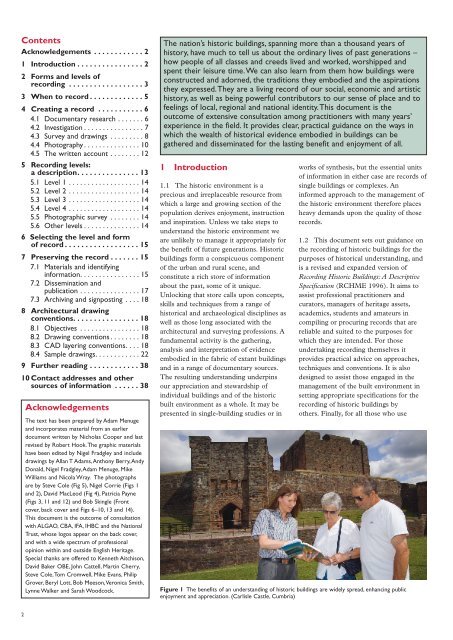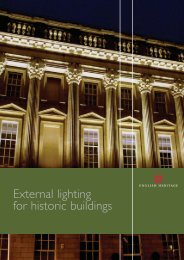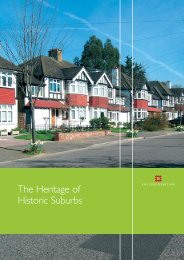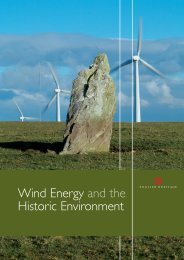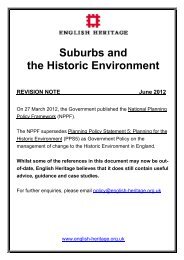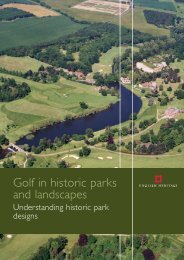Understanding Historic Buildings - HELM
Understanding Historic Buildings - HELM
Understanding Historic Buildings - HELM
Create successful ePaper yourself
Turn your PDF publications into a flip-book with our unique Google optimized e-Paper software.
Contents<br />
Acknowledgements . . . . . . . . . . . . 2<br />
1 Introduction . . . . . . . . . . . . . . . . 2<br />
2 Forms and levels of<br />
recording . . . . . . . . . . . . . . . . . . 3<br />
3 When to record . . . . . . . . . . . . . 5<br />
4 Creating a record . . . . . . . . . . . 6<br />
4.1 Documentary research . . . . . . . 6<br />
4.2 Investigation . . . . . . . . . . . . . . . . 7<br />
4.3 Survey and drawings . . . . . . . . . 8<br />
4.4 Photography . . . . . . . . . . . . . . . 10<br />
4.5 The written account . . . . . . . . 12<br />
5 Recording levels:<br />
a description. . . . . . . . . . . . . . . 13<br />
5.1 Level 1 . . . . . . . . . . . . . . . . . . . 14<br />
5.2 Level 2 . . . . . . . . . . . . . . . . . . . 14<br />
5.3 Level 3 . . . . . . . . . . . . . . . . . . . 14<br />
5.4 Level 4 . . . . . . . . . . . . . . . . . . . 14<br />
5.5 Photographic survey . . . . . . . . 14<br />
5.6 Other levels . . . . . . . . . . . . . . . 14<br />
6 Selecting the level and form<br />
of record . . . . . . . . . . . . . . . . . . 15<br />
7 Preserving the record . . . . . . . 15<br />
7.1 Materials and identifying<br />
information. . . . . . . . . . . . . . . . 15<br />
7.2 Dissemination and<br />
publication . . . . . . . . . . . . . . . . 17<br />
7.3 Archiving and signposting . . . . 18<br />
8 Architectural drawing<br />
conventions. . . . . . . . . . . . . . . . 18<br />
8.1 Objectives . . . . . . . . . . . . . . . . 18<br />
8.2 Drawing conventions . . . . . . . . 18<br />
8.3 CAD layering conventions. . . . 18<br />
8.4 Sample drawings. . . . . . . . . . . . 22<br />
9 Further reading . . . . . . . . . . . . 38<br />
10 Contact addresses and other<br />
sources of information . . . . . . 38<br />
2<br />
Acknowledgements<br />
The text has been prepared by Adam Menuge<br />
and incorporates material from an earlier<br />
document written by Nicholas Cooper and last<br />
revised by Robert Hook.The graphic materials<br />
have been edited by Nigel Fradgley and include<br />
drawings by Allan T Adams, Anthony Berry, Andy<br />
Donald, Nigel Fradgley, Adam Menuge, Mike<br />
Williams and Nicola Wray. The photographs<br />
are by Steve Cole (Fig 5), Nigel Corrie (Figs 1<br />
and 2), David MacLeod (Fig 4), Patricia Payne<br />
(Figs 3, 11 and 12) and Bob Skingle (Front<br />
cover, back cover and Figs 6–10, 13 and 14).<br />
This document is the outcome of consultation<br />
with ALGAO, CBA, IFA, IHBC and the National<br />
Trust, whose logos appear on the back cover,<br />
and with a wide spectrum of professional<br />
opinion within and outside English Heritage.<br />
Special thanks are offered to Kenneth Aitchison,<br />
David Baker OBE, John Cattell, Martin Cherry,<br />
Steve Cole,Tom Cromwell, Mike Evans, Philip<br />
Grover, Beryl Lott, Bob Meeson,Veronica Smith,<br />
Lynne Walker and Sarah Woodcock.<br />
The nation’s historic buildings, spanning more than a thousand years of<br />
history, have much to tell us about the ordinary lives of past generations –<br />
how people of all classes and creeds lived and worked, worshipped and<br />
spent their leisure time.We can also learn from them how buildings were<br />
constructed and adorned, the traditions they embodied and the aspirations<br />
they expressed.They are a living record of our social, economic and artistic<br />
history, as well as being powerful contributors to our sense of place and to<br />
feelings of local, regional and national identity.This document is the<br />
outcome of extensive consultation among practitioners with many years’<br />
experience in the field. It provides clear, practical guidance on the ways in<br />
which the wealth of historical evidence embodied in buildings can be<br />
gathered and disseminated for the lasting benefit and enjoyment of all.<br />
1 Introduction<br />
1.1 The historic environment is a<br />
precious and irreplaceable resource from<br />
which a large and growing section of the<br />
population derives enjoyment, instruction<br />
and inspiration. Unless we take steps to<br />
understand the historic environment we<br />
are unlikely to manage it appropriately for<br />
the benefit of future generations. <strong>Historic</strong><br />
buildings form a conspicuous component<br />
of the urban and rural scene, and<br />
constitute a rich store of information<br />
about the past, some of it unique.<br />
Unlocking that store calls upon concepts,<br />
skills and techniques from a range of<br />
historical and archaeological disciplines as<br />
well as those long associated with the<br />
architectural and surveying professions. A<br />
fundamental activity is the gathering,<br />
analysis and interpretation of evidence<br />
embodied in the fabric of extant buildings<br />
and in a range of documentary sources.<br />
The resulting understanding underpins<br />
our appreciation and stewardship of<br />
individual buildings and of the historic<br />
built environment as a whole. It may be<br />
presented in single-building studies or in<br />
works of synthesis, but the essential units<br />
of information in either case are records of<br />
single buildings or complexes. An<br />
informed approach to the management of<br />
the historic environment therefore places<br />
heavy demands upon the quality of those<br />
records.<br />
1.2 This document sets out guidance on<br />
the recording of historic buildings for the<br />
purposes of historical understanding, and<br />
is a revised and expanded version of<br />
Recording <strong>Historic</strong> <strong>Buildings</strong>: A Descriptive<br />
Specification (RCHME 1996). It aims to<br />
assist professional practitioners and<br />
curators, managers of heritage assets,<br />
academics, students and amateurs in<br />
compiling or procuring records that are<br />
reliable and suited to the purposes for<br />
which they are intended. For those<br />
undertaking recording themselves it<br />
provides practical advice on approaches,<br />
techniques and conventions. It is also<br />
designed to assist those engaged in the<br />
management of the built environment in<br />
setting appropriate specifications for the<br />
recording of historic buildings by<br />
others. Finally, for all those who use<br />
Figure 1 The benefits of an understanding of historic buildings are widely spread, enhancing public<br />
enjoyment and appreciation. (Carlisle Castle, Cumbria)


